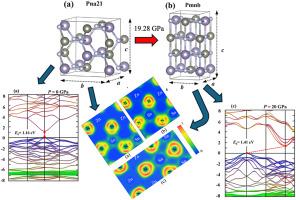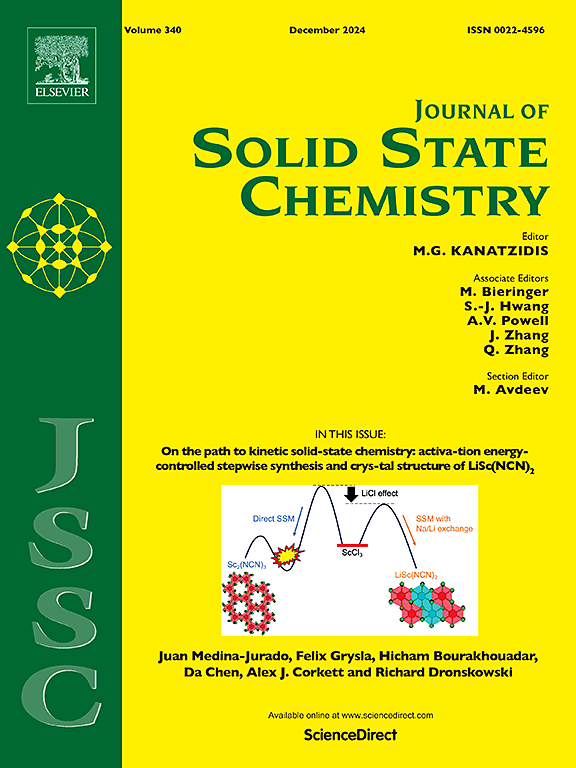ZnSnN2 中的压力诱导相变和间接带隙半导体:第一原理计算
IF 3.2
3区 化学
Q2 CHEMISTRY, INORGANIC & NUCLEAR
引用次数: 0
摘要
在这项研究中,我们利用密度泛函理论(DFT)研究了 ZnSnN2 在 0-70 GPa 压力范围内从 Pna21 到 Pmnb 的相变。我们的结果表明,Pna21 和 Pmnb 相的焓交点为 19.28 GPa,这表明 ZnSnN2 已从 Pna21 相转变为 Pmnb 相。相变前,Pna21 相在压力下的 Hv 值降低,这是因为 Sn-N 对的 G 值减小和共价键减弱。新的 Pmnb 相表现出更高的维氏硬度、德拜温度和脆性。此外,由于Γ点处导带最小(CMB)的锡 s 和 p 态以及价带最大(VBM)的 N s 和 p 态的低能级重新排列,其带隙为 1.41 eV 的间接带隙。这些特性使得 Pmnb 相有望应用于需要较长载流子寿命的领域。我们对其机械特性、动力学行为和电子局域函数(ELFs)进行了研究和讨论。本文章由计算机程序翻译,如有差异,请以英文原文为准。

Pressure-induced phase transition and indirect band gap semiconductor in ZnSnN2: First Principles Calculation
In this study, we investigate the phase transition of ZnSnN2 from Pna21 to Pmnb using Density Functional Theory (DFT) across a pressure range of 0–70 GPa. Our results show the enthalpy intersection of the Pna21 and Pmnb phases at 19.28 GPa, indicating a phase transition from Pna21 to Pmnb ZnSnN2. The decrease in Hv of the Pna21 phase under pressure before the phase transition is attributed to the reduction of the G and weakening covalent bond of Sn–N pair. The new Pmnb phase exhibits an increased Vickers hardness, Debye temperatures, and brittleness. Moreover, the band gap is an indirect band gap of 1.41 eV due to a rearrangement of lower energy levels for Sn s and p states in conduction band minimum (CMB) and N s and p states in valence band maximum (VBM) at Γ-point. These characteristics make The Pmnb phase promising candidates for applications were longer carrier lifetimes are needed. The mechanical properties, dynamical behavior, and electron localization functions (ELFs) have been investigated and discussed.
求助全文
通过发布文献求助,成功后即可免费获取论文全文。
去求助
来源期刊

Journal of Solid State Chemistry
化学-无机化学与核化学
CiteScore
6.00
自引率
9.10%
发文量
848
审稿时长
25 days
期刊介绍:
Covering major developments in the field of solid state chemistry and related areas such as ceramics and amorphous materials, the Journal of Solid State Chemistry features studies of chemical, structural, thermodynamic, electronic, magnetic, and optical properties and processes in solids.
 求助内容:
求助内容: 应助结果提醒方式:
应助结果提醒方式:


